Table of Contents
Fatigue performance of DMLS/SLS: Post-processing procedures
The post-processing procedures are used to change the microstructure and surface quality of the as-built products. Since both microstructure and surface quality affect mechanical properties of products, the post-processing procedures influence fatigue performance of the products of DMLS/SLM technologies. Furthermore, as different processing steps have different influences to microstructure and surface quality, the order of their application may also affect the mechanical properties and fatigue performance of DMLS/SLM products.
This page represents the introductory page to the sections that present influence of particular post-processing procedures machining, shot-peening and heat treatment to fatigue performance of DMLS/SLM products.
Order of the post-processing procedures
The influence of shot-peening, machining and heat treatment is discussed in individual pages, and here will only briefly be discussed the order of the three post-processing procedures.
The usual post-processing procedures is to apply heat treatment after shot-peening and before machining.
However, if heat-treatment is not used, somewhat better fatigue performance may be obtained in maraging steel MS1 and stainless steel by shot-peening of the surface after machining. Such order of post-processing procedures, however, has detrimental effect to surface roughness of the obtained products, and is not acceptable in many applications.
In the case of maraging stainless steel CX, the same effect is observed even when machining and shot-peening are applied after heat-treatment.
Mechanism of influence
The usual, and recommended, order of the three post-processing procedures is to apply heat treatment after shot-peening and before machining, because heat-treatment increases hardness (that reduces effects of shot-peening) and leads to formation of oxidized layer at surface (that is removed by machining).
On the other hand, due to the specific structure of DMLS/SLM technologies, machining of DMLS/SLM products reduces two benefits of shot-peening:
- DMLS/SLM causes larger density of internal and surface voids in materials than traditional manufacturing technologies, and shot-peening closes pores on the surface of material; however, machining removes the layer with closed pores and uncovers internal defects which become surface defects in the process of machining;
- DMLS/SLM cause residual tensile stress, which are removed by shot-peening that creates a surface layer with compression stresses; machining removes the layer with compression stresses and uncovers material with tensile stresses;
Since pores on surface represent one of the sources of initial cracks, and tensile stresses facilitate propagation of cracks, one may expect that the products post-processed by machining after shot-peening may have worse fatigue performance than the products post-processed by machining before shot-peening. However, such post-processing order is not acceptable in many engineering fields where high surface quality is required from the product, as it is the case with tooling applications. Nevertheless, for the sake of complete information, the comparison of fatigue performance of the samples of different materials produced using the two post-processing orders is given below.
S-N curves and fatigue limits
The following figures and tables present the results of the studies of the influence of the order of post-processing procedures of samples to fatigue performance in finite life domain and fatigue limit of maraging steel MS1, stainless steel PH1 and maraging stainless steel CX obtained during the A_MADAM project. The outline of the tables follows the notation and conventions described at the page Fatigue design rules for DMLS/SLM products. The orders of prost-processing procedures applied to the samples are denoted in figures by abbreviations “SM” (without heat-treatment, shot-peening before machining), “MS” (without heat-treatment, shot-peening after machining), “SMT” (the usual shot-peening/heat-treatment/machining post-processing sequence) and “TMS” (the studied heat-treatment/machining/shot-peening post-processing sequence).
Maraging steel MS1
The comparison of the fatigue performances in the finite life domain of samples manufactured with different processing orders is presented in the following two figures. The first figure presents comparison of S-N curves of samples post-processed without heat-treatment, while the second figure presents comparison of S-N curves of samples post-processed with heat-treatment. The allowance for machining was 0,5 mm in both cases. The figures indicate that the fatigue performance in the finite life domain of the samples subjected to shot-peening before machining (red circles) seems worse than fatigue performance of samples that were submitted to shot-peening after machining (green circles) but it is obvious that the heat-treatment reduces, and even reverses, the observed difference. The influence of heat-treatment is discussed in the dedicated page. Therefore, if heat-treatment is not applied, the improvement of fatigue performance of MS1 products is possible by shot-peening after machining, in cases that surface quality that remains after shot-peening is acceptable for the application.
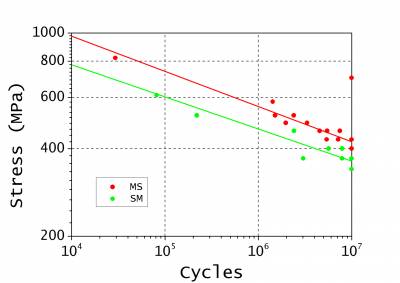
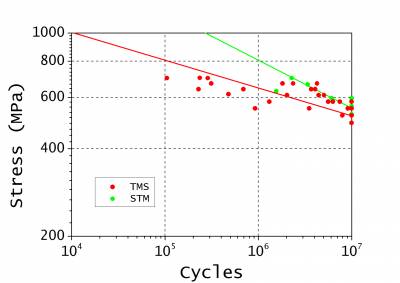
The comparison of the fatigue performances in the infinite life domain of samples manufactured with different orders of is presented in the following figure. The order of the post-processing procedures is indicated at the abscissa.
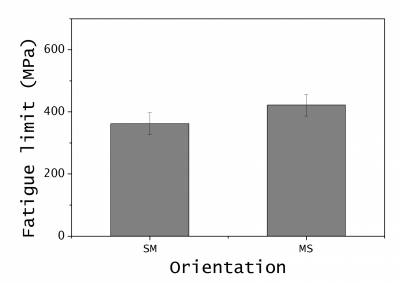
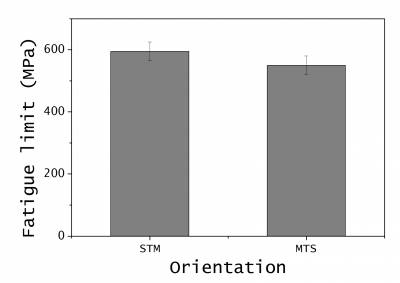
The S-N curves and the values of fatigue limits shown above may be seen at the pages dedicated to specific combinations of manufacturing conditions and post-processing procedures, listed in the table below.
Stainless steel PH1
The comparison of the fatigue performances in the finite life domain of samples manufactured with different processing orders is presented in the following two figures. The first figure presents comparison of S-N curves of samples post-processed without heat-treatment, while the second figure presents comparison of S-N curves of samples post-processed with heat-treatment. The allowance for machining was 0,5 mm in both cases. The figures indicate that the fatigue performance in the finite life domain of the samples subjected to shot-peening before machining (red circles) seems worse than fatigue performance of samples that were submitted to shot-peening after machining (green circles) but it is obvious that the heat-treatment reduces the observed difference. The influence of heat-treatment is discussed in the dedicated page, but it should be noted here that it is a necessary post-processing step for PH1 products. Therefore, the improvement of fatigue performance of PH1 products that may be obtained by post-processing without heat-treatment but with shot-peening after machining is not of practical relevance.
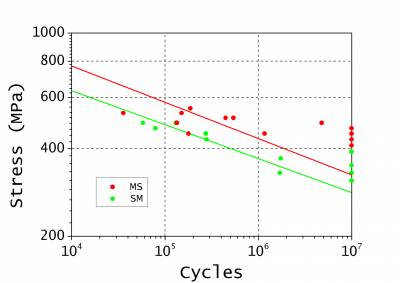
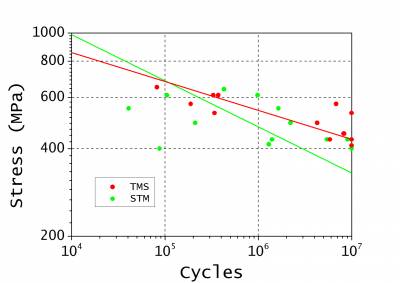
The comparison of the fatigue performances in the infinite life domain of samples manufactured with different orders of is presented in the following figure. The order of the post-processing procedures is indicated at the abscissa.
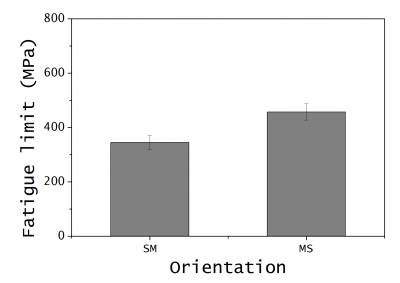
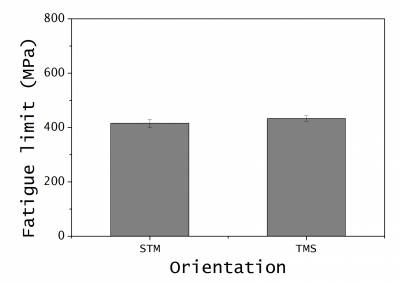
The S-N curves and the values of fatigue limits shown above may be seen at the pages dedicated to specific combinations of manufacturing conditions and post-processing procedures, listed in the table below.
Maraging stainless steel CX
The comparison of the fatigue performances in the finite life domain of samples manufactured with different processing orders is presented in the following figure. While the fatigue performance in the finite life domain of the samples subjected to shot-peening before heat-treatment and machining (red circles) seems worse than fatigue performance of samples that were submitted to shot-peening after heat treatment and machining (green circles) (similar to the behaviour observed with MS1 and PH1), the statistical analysis could not exclude the possibility that the observed differences are random, so the influence of order of shot-peening and machining to the fatigue performance of maraging stainless steel CX still may not be confirmed. The allowance for machining was 0,5 mm in both cases.
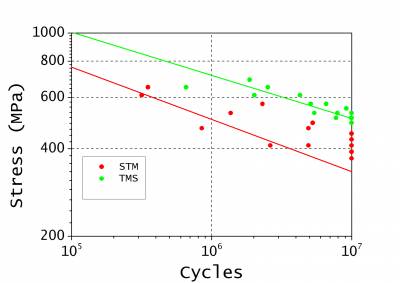
The comparison of the fatigue performances in the infinite life domain of samples manufactured with different orders of is presented in the following figure. The order of the post-processing procedures is indicated at the abscissa.
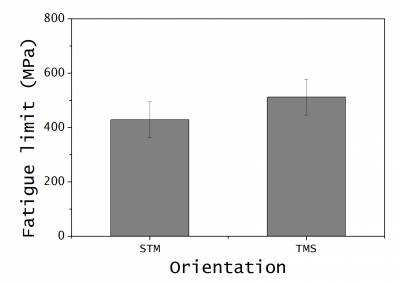
The S-N curves and the values of fatigue limits shown above may be seen at the pages dedicated to specific combinations of manufacturing conditions and post-processing procedures, listed in the table below.
